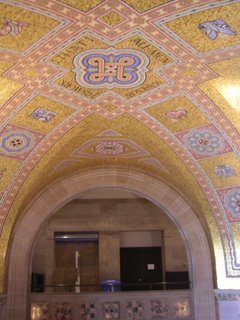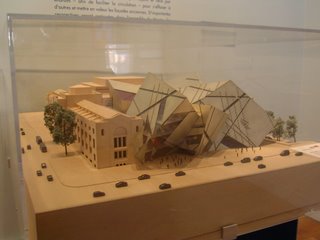Random stuff
Hi!
Did you know that Canada was originally named the Commonwealth Northern Development? The name Canada didn't come until later when people in the house of parliament in Ontario were thinking aboot the acronym CND. Someone said out loud: "So the acronym goes C - eh? - N - eh? - D - eh?" and the name CANADA was born...
I'm quite happy with myself because I actually wrote some music in the past week. And I _finished_ a song! This hasn't happened in a long time. So long in fact that my music files, even those that were on the "drawing board" have been compressed by the "compress old files" option of the disk cleanup wizard. I now have almost enough music for the second album! (ooooohh! aaaaahhh!)
Here's a couple of photos from our recent trip to the Royal Ontario Museum in Toronto (about 2 1/2 weeks ago). I didn't take many because they asked for no flash photography and my camera was being disobedient.
 This is the ceiling of the main entrance. It's a pretty old and impressive building, some parts of which look more like a cathedral. The writing on the ceiling says "That all men may know his work," which is not something I expected to find in a museum...
This is the ceiling of the main entrance. It's a pretty old and impressive building, some parts of which look more like a cathedral. The writing on the ceiling says "That all men may know his work," which is not something I expected to find in a museum...
The museum is being renovated at the moment - they're adding a big crystalline splat on the outside which you can see in this scale model. It reminds me of what they did to the Louvre, where they added a big "modern" bit to an otherwise extremely old and stylish building. As you can guess, there's lots of opposition to this modernisation. I think it will be interesting, but I agree that the new section will probably date pretty quickly.
We stayed at the ROM for most of the afternoon (making the most of the fact we'd spent 2 hours or so just getting there from Dundas) and we saw the Native Canadians exhibition which had lots of interesting items of weapons and clothing, early canoes, and a selection of native art. The exhibition was, unfortunately, a little too focussed on the explorers who obtained the items, at the expense of beign rather light on information about the items themselves. We're told a few graphics were still missing from a recent move of the gallery, so maybe it'll be better next time.
We visited a few other exhibits including the Lalique glass sculpture exhibit, the Egyptian gallery, some 16th and 17th century suits of armour, and a collection of art-deco furniture. They also had an Islamic exhibition which had a bit about the fundamentals of Islam and the history of Mohammad. As with Christanity, there are a few inconsistencies. For example, although Mohammad did a lot of preaching about adhering to a strict moral code, he saw fit to take over Mecca by force to establish the first Islamic state. I don't think this event plays a big part in Islamic teaching, but it's not a terribly good example for God's prophet to be setting. In the following centuries, the word "conquest" was used to describe the fashion in which the Islamic state grew; some of the areas converted willingly, but it's not clear what happened in the other areas.
Another interesting bit of information was that Mohammad sanctioned both the old and new testaments of the bible. Apparently Mohammad got some of his ideas - monotheism, rewards in an afterlife - from talking to Christian merchants from the west (Mohammad was himself a merchant). Mohammad presumably never actually read the bible, which would explain why he also said that Jesus wasn't the son of God, and didn't die on the cross (Christian websites focus on these differences rather than the similarities). Mohammad appears to have been illiterate, and chose to preach directly to crowds in Mecca where he lived. Some of his followers wrote down what he said, and this collection of writings were eventually put together to form the Koran.
It wasn't until about a century after his death that Muslim clerics saw fit to commit the Islamic moral code to writing (something Mohammad had argued against) in the form of a text called the Hadith. The Koran talks more generally about morals, but the Hadith prescribes things like prayers 5 times a day, and could be the origin of Sharia Law (as distinct from Sharia which just means practising Islam). The Hadith comes in various strengths, and appears to play a similar role in Islam that various sects and denominations of Christian churches play.
One point that struck me as amusing was that Mohammad was against the worship of monuments at Mecca. The ruined building in the middle of Mecca predates Mohammad by a couple of centuries, and Mohammad saw this as part of a bigger problem of idol worship. How exactly the pilgrimage to Mecca worked its way into being one of 5 core tenets of Islam isn't clear, although there is plenty of sense in travelling to the birthplace of Islam. Most likely the two ideas were amalgamated in much the same way that the Christian holy days of Christmas and Easter just happened to coincide with Pagan festivals. I'm not sure that Mohammad would really have cared that much. He was more interested in stamping out corruption, drunkenness and debauchery, which he saw as being the cause of poverty and hardship, which he'd experienced first hand when growing up.
Hmmm... so it's possible to pick and choose the parts of the Islamic story to justify some pretty extreme action. It's also possible to pick and choose the sensible parts and come up with a moderate religion. Sounds like most religions really... Please note that I haven't rigorously checked many of these facts, and I suspect many of them are disputed by historians anyway. And I've left bits out (like I didn't bother to mention the Archangel Gabrielle at all...). So there.
--
This post has been brought to you by Cheese Delivery.
"If you want cheese
Delivered to your door
You just call
Cheese delivery."
Just call 1800 CHEESED or visit www.cheesedelivery.com

0 Comments:
Post a Comment
<< Home